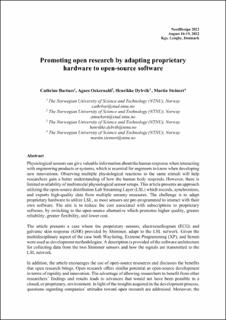| dc.description.abstract | Physiological sensors can give valuable information about the human response when interacting with engineering products or systems, which is essential for engineers to know when developing new innovations. Observing multiple physiological reactions to the same stimuli will help researchers gain a better understanding of how the human body responds. However, there is limited availability of multimodal physiological sensor setups. This article presents an approach utilizing the open-source distribution Lab Streaming Layer (LSL) which records, synchronizes, and exports high-quality data from multiple sensory measures. The challenge is to adapt proprietary hardware to utilize LSL, as most sensors are pre-programmed to interact with their own software. The aim is to reduce the cost associated with subscriptions to proprietary software, by switching to the open-source alternative which promotes higher quality, greater reliability, greater flexibility, and lower cost. The article presents a case where the proprietary sensors, electrocardiogram (ECG) and galvanic skin response (GSR) provided by Shimmer, adapt to the LSL network. Given the multidisciplinary aspect of the case both Wayfaring, Extreme Programming (XP), and Scrum were used as development methodologies. A description is provided of the software architecture for collecting data from the two Shimmer sensors and how the signals are transmitted to the LSL network. In addition, the article encourages the use of open-source resources and discusses the benefits that open research brings. Open research offers similar potential as open-source development in terms of rapidity and innovation. The advantage of allowing researchers to benefit from other researchers’ findings and results leads to advances that would not have been possible in a closed, or proprietary, environment. In light of the insights acquired in the development process, questions regarding companies’ attitudes toward open research are addressed. Moreover, the article adds to the field of open research by broadening the possibilities for experimental setups facilitating the acquisition of new knowledge. | en_US |
